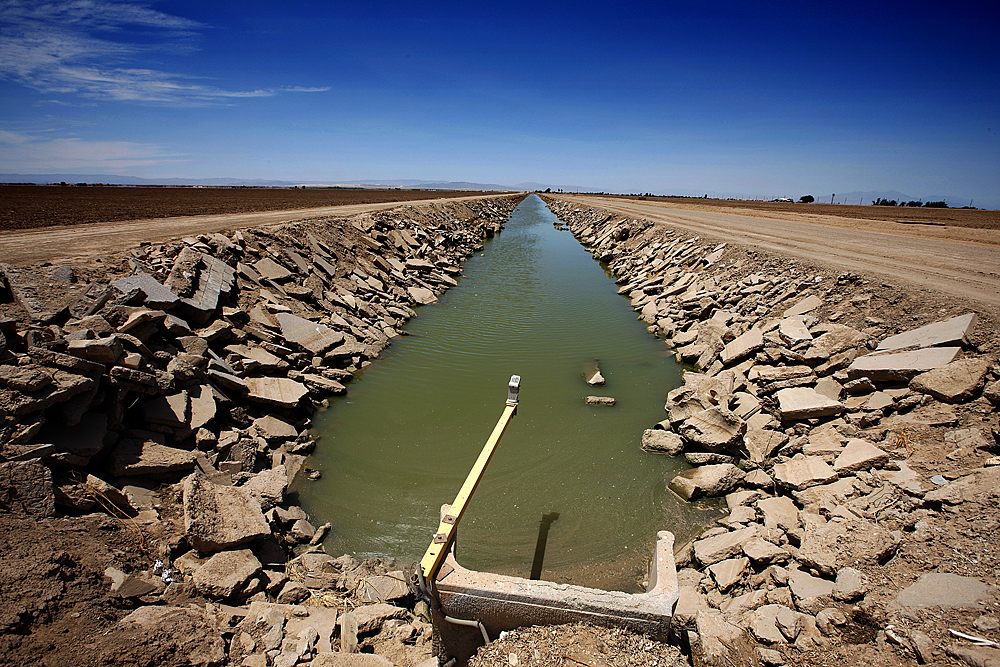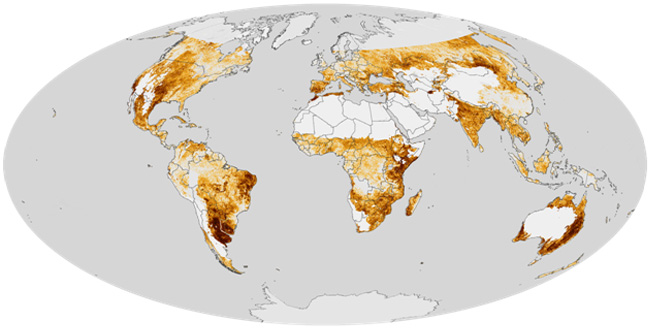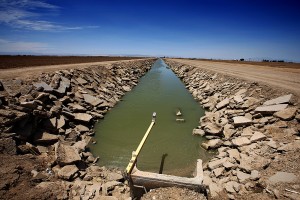July 2, 2014 – It may not be the heat or rising sea levels, or even frequent severe weather events that create the greatest challenge to humanity and other life on the planet. Instead it could be the absence of freshwater.
In preparing my speech to the Jamaica2030 conference I came across the following statistic:
A quarter of the planet will experience severe water shortages one month per year by 2030.
What will be the reasons?
- Wasteful use of freshwater.
- Depleted aquifers because of overuse.
- Declining precipitation and prolonged droughts leading to depletion of surface and subsurface water resources.
A map posted on the Geospatial World website, reproduced below, shows those ares of the planet that have faced significant drought since 1981. Note in the image that the polar regions remain blank because of insufficient data. And areas like the Australian Outback, the Sahara and deserts of Southwest Asia, already in permanent drought, remain blank as well.
But the tinted areas that go from light to dark are the ones of concern. These are areas that have had a wetter past but are now experiencing change with the darkest representing the most prolonged water shortages accompanied by significant crop failures and natural vegetation loss.
In my talk at Jamaica 2030 I mentioned that the World Water Development Report 4, issued by the United Nations, forecasted that half of the world’s human population in 2030 will live in freshwater stressed areas. A quarter billion of them will live in Sub-Saharan Africa and will join a growing number of climate refugees.
There is no immediate remedy to come from a carbon reduction strategy. So by burning less coal and other fossil fuels in the immediate future we cannot alter the pattern we are witnessing even though human-assisted climate change is part of the cause. The other human contribution is overpopulation in both people and the domesticated flocks of animals we rely on for part of our food supply.
So what can we do to mitigate freshwater scarcity?
- Conserving freshwater is the primary weapon in our arsenal of solutions. We can do this through better farming practices – by moving away from spraying to drip technologies for irrigation, through no till farming practices, and by recapturing and reusing grey water output. We need to use the freshwater we extract repeatedly and not just once.
- Rethinking where humans settle in urban and rural areas and where we farm. The American movement to the Southwestern U.S. has directly contributed to freshwater decline. So has the mass irrigation of areas of the American Midwest where marginal precipitation has been heavily supplemented by drawing water from deep aquifers, depleting them to an unsustainable level.
- Reforesting areas currently producing marginal agricultural output. Forests play a significant role in restoring freshwater to their local environment. In the case of the Amazon and Congo rainforests, they are virtually the lungs of the planet, contributing to an atmospheric water vapour stream that circles the globe.
- Allowing dryland zones on the planet to return to natural vegetation. Biology took millions of years to develop plant species suitable for areas we farm today. And these areas are at best marginal until we add freshwater to them from unsustainable sources. It would be best if we let these areas return to their natural state while we find new ways to produce what we eat.
- Developing urban farms and closed biome technologies that not only produce the food we eat where the bulk of our population locates, but also through these technologies reducing water usage per kilogram of output.
- Managing population growth. We are moving towards an estimated 9 billion plus population by 2050. And although the planet has enough arable land to feed significantly more than 9 billion, the challenges to do this become far more daunting with freshwater scarcity.
- Desalination technologies can help mitigate freshwater scarcity in coastal areas but this is energy intensive and expensive. It also can further damage the ocean and seawater areas from which the water is extracted by altering local chemistry.
- Freshwater extraction from air, low technology solutions are being deployed but these mitigate immediate subsistence needs for local populations, but are not macro solutions to the problem of freshwater scarcity.
This list is by no means complete. I invite you to suggest additional strategies we can deploy to address what may prove to be the most significant immediate challenge we face as an outcome of human influenced climate change.



















Dear Len
I attended Al Gores Climate Reality Training in Johannesburg recently, what I loved the most about the training is that it was like minded individuals gathering to share information and experience.
There were several videos showing how extreme storms are thundering out of the sky dumping masses of water on the earth in short spaces of time, often causing enormous run off and damage to top soil because it’s to much in one go. So there is masses of “fresh” water coming from the sky, BUT it does not have time to settle and seep into the earth to be stored in natural underground reservoirs.
It may sound crazy, but extreme times sometimes call for extreme measures and perhaps it will be a viable idea to create underground reservoirs and “funnel” the water from these extreme downpours into the man made underground reservoirs. Underground will also assist with the reduction of surface evaporation and conserve the water source.
In South Africa I lived in a cottage on a small residential property where the man that originally designed and built the house created an underground reservoir under his house and all the gutters run directly into the reservoir, this was an amazing achievement back in the 1980’s when he built the house and the reservoir sustains the house with water for the vegetable garden and ponds on the property for months on end. That is small scale, but it was made feasible.
Hi Nadine, Capturing runoff is a tried and true method of ensuring adequate freshwater supply particularly in areas of our planet where rainfall is the principal water source. Your South African example has been repeated many times in different parts of the world. When my wife and I vacationed in Bermuda we noted that the roofs were designed to channel water into holding tanks to provide water for drinking and household sanitation. Bermuda has no streams or other natural freshwater sources.
But the problem with extreme rainfall events is their ability to overwhelm infrastructure designed to retain freshwater. In a matter of minutes when a lake-sized deluge descends how do you contain it safely? Unless you are building infrastructure on an enormous scale, the best you can do is retain some of it while you apply flood control technology to ensure what you can’t capture can at least be channeled away safely.
In Canada we have many rivers that flow south to north. That means spring melt occurs at the source sooner than at river end point. This leads to ice dams as water surges northward. That means floods of enormous size. We build levees and berms and huge diversion ditches to contain the excess flow. And we even do this in areas that may experience drought conditions later in the summer. Natural ponding is the only freshwater retention strategy. There has to be a smarter way to manage freshwater in such areas but we have yet to make the necessary investment to achieve stable year-round freshwater even in our country where the resource is abundant.